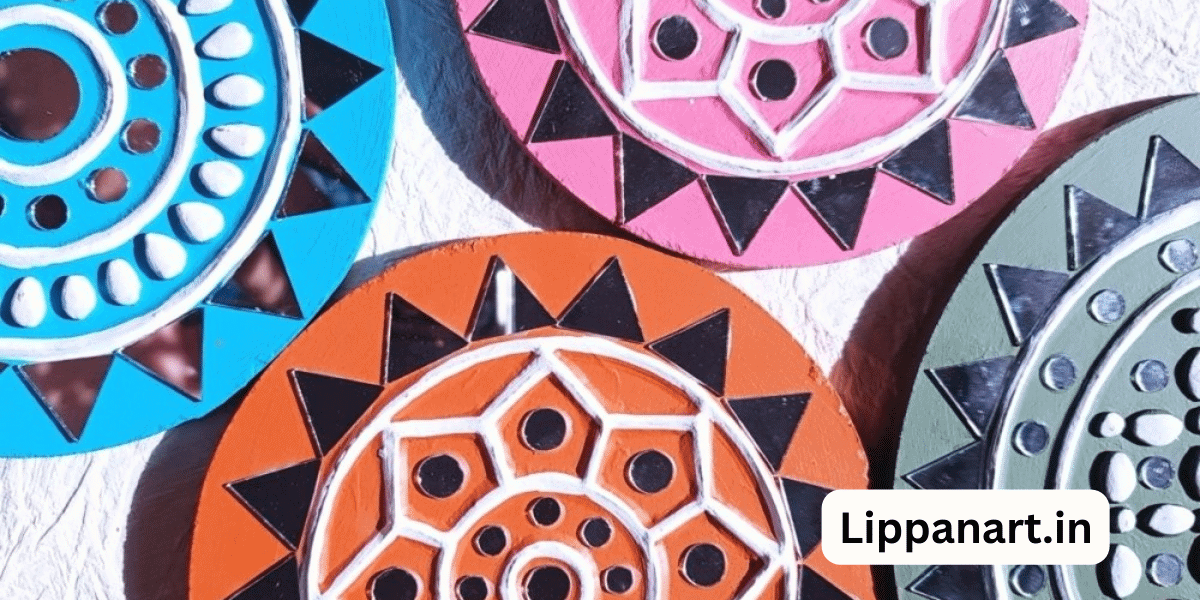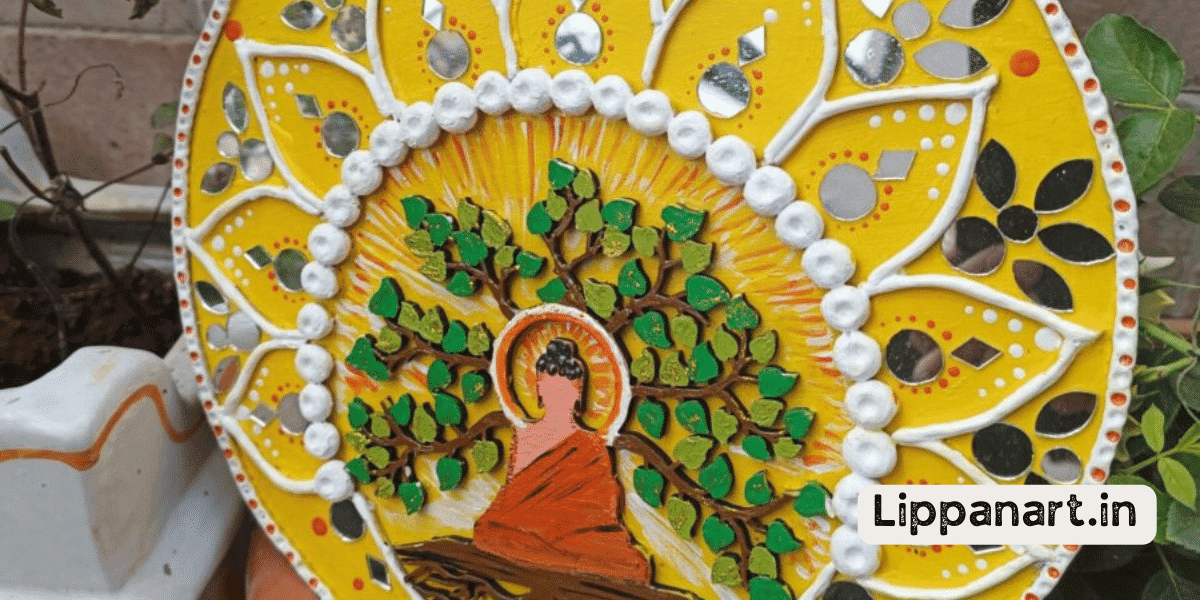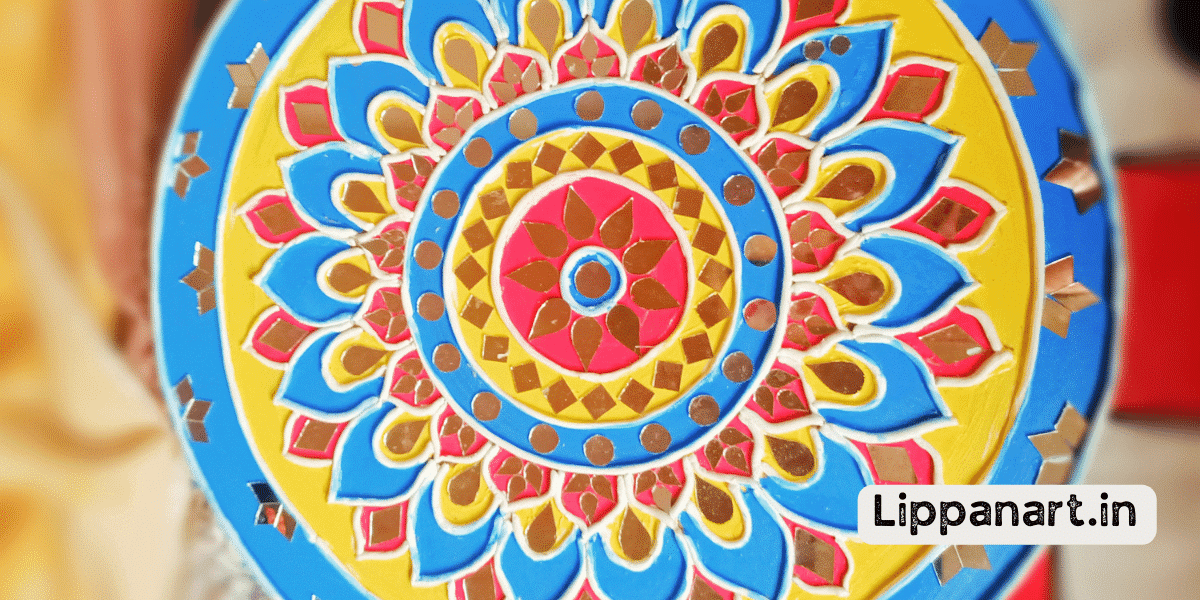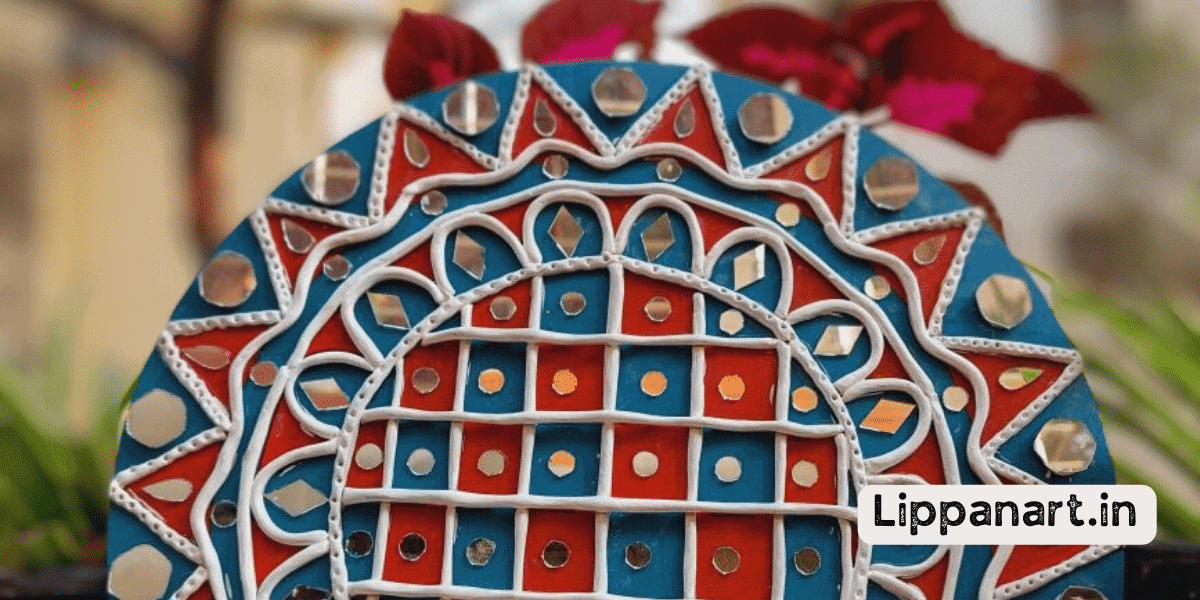Have you ever marvelled at the intricate art of Lippan, wondering how this traditional craft can be adapted to the modern age?
Well, consider the potential of plywood! With its affordability, adaptability, and strength, plywood is a perfect substrate for creating stunning Lippan art.
Let’s explore how you can use this versatile material to create unique pieces of art that will last for years.
Exploring Alternative Substrates
You may have heard of Lippan art, the traditional wall art created with mud and mirrors.
But did you know that plywood can also be used as a canvas for this art form?
Using plywood to create Lippan art has many advantages, such as its lightweight, portable nature and its ability to be reused and shaped into multiple forms.
It also has a unique look that can bring a certain level of sophistication to any piece of art.
Let’s explore the possibilities of using plywood as a canvas for Lippan art.
Plywood as a Canvas
Plywood can be used as a canvas for lippan art. It’s an excellent choice for anyone looking for a unique design and a creative way to express themselves. Plywood is a strong, lightweight material that is easy to work with and economical. It can be cut, sanded, and painted to create a beautiful piece of artwork. Plywood can also be used as the backing for a lippan art piece, providing stability and support for the design.
MDF board is another option if you’re looking for an alternative to plywood. It’s a great choice for those who want a sturdier, more durable substrate. MDF board is more expensive than plywood, but it’s a great option for those looking for a longer-lasting piece of artwork.
| Substrate | Strength | Cost |
|---|---|---|
| Plywood | Strong | Low |
| MDF Board | Sturdier | High |
Advantages of Plywood
Plywood has many advantages as a canvas for art. It’s an ideal wall panel for Lippan art, as it provides a sturdy base to apply the clay and other materials necessary for the intricate art form. Its smooth surface is also perfect for creating intricate designs. Additionally, plywood is affordable compared to other materials, so you can create beautiful art without breaking the bank.
You can easily manipulate the material with the right clay tool to create the desired look. Whether using plywood for traditional Lippan art or something more modern, the material is optimal for any art.
Preparing Plywood for Lippan Art
Preparing plywood for lippan art is a critical step in the process. Before you can apply the intricate designs, you’ll need to ensure the surface is properly prepared.
This includes cleaning, sanding, priming, and sealing it. These steps will ensure that the paint has a smooth, even surface to adhere to and that your design will look its best.
By preparing properly, one can produce breathtaking lippan art patterns.
Surface Preparation
To prepare your plywood for lippan art, you’ll need to sand it down. Start using medium-grade sandpaper to remove rough edges or splinters, then switch to a finer grade to create a smooth finish.
Use a quality board such as MDF Pine Board or hardwood plywood for the best results.
To ensure your art’s best adhesion and performance, use primer on the plywood before you start painting.
If you plan on selling your lippan art, consider investing in secure payments to ensure safety and satisfaction for your customers.
With the right preparation, your plywood will be ready to become a stunning piece of lippan art!
Priming and Sealing
Once your plywood is sanded and smooth, it’s time to prime and seal it for your lippan art.
To start, gather the essential tools you’ll need: a paintbrush, base coats, a roller, and kutch lippan mud.
To start, put a thin layer of primer on the plywood. It is important to wait for the surface to completely dry before applying two base coats of paint.
Once the base coats are dry, the roller spreads a thin layer of kutch lippan mud onto the plywood. This will create an even, glossy surface that will make your lippan art shine.
Finally, use the paintbrush to create your desired design.
You can make a stunning lippan art piece on plywood with the right tools and techniques.
- Editor’s Choice
- Best Seller
- Amazon Choice
Adapting Techniques for Plywood
When adapting techniques for plywood to create Lippan art, there are a few things to remember.
First, you need to be mindful of the mixture you use to apply the Lippan – it should be a non-toxic, water-based mixture that won’t damage the plywood.
You also need to consider the textures and patterns you want to create, as plywood can be a bit more difficult to work with than other surfaces.
Applying Lippan Mixture
Applying the lippan mixture to plywood requires a specific technique. To create contemporary lippan art, you’ll need to:
- Gently sand the panel with fine-grain sandpaper.
- Apply a primer to the panel, allowing it to dry completely.
- Blend the lippan mixture, adding a few drops of water to get the desired consistency.
- Carefully apply the mixture to the panel using a brush or palette knife.
You can create stunning contemporary lippan art with plywood with the right technique. The key is using a light touch and carefully working the mixture into the panel until the desired effect is achieved.
It’s highly recommended to experiment with various materials and techniques
when creating a work of art to achieve the perfect combination and a beautiful result.
Creating Textures and Patterns
You’ll need to experiment with different tools and techniques to create unique textures and patterns with your lippan art. Create vibrant colours and intricate designs to bring your work to life.|
| Tool | Technique |
|---|---|
| Sponges | Blending |
| Stencils | Stamping |
| Pencils | Drawing |
Use repetitious patterns to create movement and flow throughout your designs. Try using a wooden stylus to make impressions on the surface. For a more textured look, layer on different coloured clays. Finally, use a brush to add a polished finish. You can create a captivating piece of lippan art with the right tools and techniques.
Showcasing Plywood Lippan Art
You can create beautiful, unique art pieces with plywood and lippan art.
As you consider the aesthetic of your creation, you can use the rich texture of plywood and experiment with the creative opportunities of lippan art.
You can also explore a variety of colours and shapes, allowing you to add a personal touch to your artwork.
Aesthetic Considerations
Using plywood for lippan art can often create a more modern look than traditional cloth and mud, but it’s important to consider the aesthetics of the finished product.
As you design your lippan art, think about the following design elements:
- The colour wheel: Use different colours to create a visually stimulating piece.
- Texture: Plywood can be painted, stained, or left raw for a unique effect.
- Light: How will the light affect the piece?
- Proportion: The size of the pieces should be in balance with each other.
Creative Opportunities
Now that you’ve considered the aesthetic considerations of using plywood for lippan art let’s explore the creative opportunities it offers.
With plywood, you can craft intricate lippan designs and patterns, pushing the boundaries of your imagination. Its versatility allows you to experience new possibilities, expand your knowledge, and take your art to the next level.
The key is experimenting with different shapes, sizes, and colours, allowing your creativity to flow freely. Plywood is the perfect material for anyone looking to make a statement with their lippan art. Let it be a reflection of your unique vision and experience.
Longevity and Maintenance
When it comes to Plywood Lippan Art, durability, protection, and preservation are key.
You’ll want to ensure the plywood is treated with a protective layer to help it last longer and look great.
Properly caring for the wood will help maintain its longevity and keep it looking like new for years to come.
A few simple steps, like regularly cleaning, treating, and covering the wood, can make a big difference in the life of your lippan art.
- Editor’s Choice
- Best Seller
- Amazon Choice
Durability
You’ll find that plywood is quite durable for lippan art. Crafted from layers of wood, plywood is sturdy and strong, making it perfect for intricate art that will last through time.
Here are four reasons why plywood is a great choice for lippan art:
- Strength: Plywood is strong enough to stand up to whatever life throws at it, making it a great choice for long-term projects.
- Flexibility: Plywood is flexible enough to fit into any space, providing a product tailored to your needs.
- Customisation: Plywood can be customised to your liking, with different patterns and colours to suit your unique style.
- Longevity: With proper maintenance, plywood can last for years, giving you a product you can enjoy for a long time.
Plywood is an excellent choice for lippan art, offering durability that won’t
disappoint you. Your project is built to last, with durable and adaptable features that provide long-lasting protection and preservation.
To ensure your lippan art stays safe and preserved, it’s important to protect it properly. Plywood is a great option as it offers dependable defence against daily use and damage. It can help keep your lippan kaam looking beautiful for years, despite the passage of time.|
| Advantages | Disadvantages |
|---|---|
| Water-resistant | Expensive |
| Lightweight | It can be not easy to work with |
| Durable | Can warp over time |
| Easy to clean | Not as strong as other types of wood |
Plywood provides a great way to protect your finished piece from scratches, dents, and other damage. It is also fire-resistant, making it an ideal choice for areas prone to wildfires. Plywood is an ideal choice for those looking for a way to preserve their lippan art for the long term.
Comparing Substrates: Plywood vs. Traditional Surfaces
Regarding lippan art, it’s important to consider what substrate you choose — traditional surfaces or plywood.
Traditional surfaces such as paper, canvas, or board have been used for centuries and offer a classic look. But they do have their pros and cons.
Plywood, on the other hand, is a newer option with its own unique set of advantages and drawbacks.
In this discussion, we’ll explore the benefits and drawbacks of traditional and plywood surfaces for lippan art.
Traditional Surfaces
You’re likely familiar with traditional surfaces used for lippan art, such as mud, clay, and cloth. But other materials can also be used, such as paper, glass, and wood.
Each of these materials offers unique benefits, including:
- Colour blending for a truly unique piece
- Intricate patterns for a more complex design
- Durability for a long-lasting art object
- Lightweight material for easy transport
Traditional surfaces provide a great opportunity to create innovative and eye-catching art pieces. With lippan art, you have the chance to experiment with different materials and create a piece that is truly unique.
With the right materials and techniques, you can bring your ideas to life and create a one-of-a-kind art piece that will last for years.
Pros and Cons
Considering traditional surfaces for your lippan art project? It’s important to weigh the pros and cons before you start.
Plywood is an ideal surface for lippan art, offering a sturdy yet lightweight base for intricate designs. It’s also cost-effective, easy to find, and easy to cut.
On the other hand, plywood can be difficult to paint, may warp over time, and can be difficult to clean. If you’re looking for a more durable option, consider hardboard or a thicker grade of plywood.
Ultimately, deciding which surface best suits your needs and creative vision for your lippan art is up to you.
Inspiring Innovation
You can push creative boundaries and encourage experimentation with inspiring innovation.
Look for ways to challenge yourself and explore new ideas, and you’ll soon find that you’ve opened up a world of possibilities.
Innovative thinking is a great way to expand your skill set and create something unique.
Pushing Creative Boundaries
Exploring using plywood for lippan art is a great way to push creative boundaries. It offers a unique set of design considerations that promote creative and innovative uses of tools. Here are four ways that plywood can help you to expand your lippan art:
- Create intricate designs with laser-cut tools
- Experiment with shapes and sizes of wood
- Utilise a variety of colours and textures
- Incorporate a mix of hand-crafting and technology
These methods allow for a new level of expression in lippan art. Using plywood can help you explore innovative approaches and open up a world of possibilities.
It is an excellent way to challenge your creative boundaries and craft inspiring works of art.
Encouraging Experimentation
Encouraging experimentation with plywood lippan art is essential to pushing creative boundaries. You can create a unique piece with different design ideas, bright colours, and shapes. Try combining different textures or mixing different materials to create an eye-catching effect.
Experiment with different kinds of plywood and different types of glue to find the combination that works best for creating lippan art. The more you experiment, the more creative you can get with your lippan art. Feel free to try something different and explore all the possibilities that plywood can offer.
Who knows, you may even create something amazing that breaks the boundaries of traditional lippan art!
Frequently Asked Questions
What Is the Best Type of Plywood to Use for Lippan Art?
You’ll want a type of plywood that is lightweight yet strong enough to hold the shape of the lippan art. Consider using quality birch or maple plywood to create a lasting, eye-catching piece of art.
How Long Does a Lippan Art Piece Made of Plywood Typically Last?
A lippan art piece’s longevity from plywood depends on its environment and care. Proper protection from water and humidity can last for many years. Using quality plywood and proper maintenance, your lippan art can be enjoyed for years.
What Is the Best Way to Seal Plywood Lippan Art?
Sealing plywood lippan art is like putting the final brushstroke on a masterpiece. Choose a sealant that is durable and water-resistant for lasting protection. With the right tools, you can make your creation shine, standing proud for years.
Are Any Traditional Techniques That Cannot Be Adapted for Use With Plywood?
You may find that some traditional techniques for lippan art cannot be adapted for use with plywood. Consider the tools and techniques needed to create intricate designs – the detail needed for lippan art may not be possible with plywood. Explore alternative methods to achieve the same effect.
Can Plywood Lippan Art Be Safely Displayed Outdoors?
You can display plywood lippan art outdoors, using sealants and protective coatings to ensure it lasts. Weatherproofing is key to maximising longevity and keeping your artwork looking great!
Conclusion
You’ve seen how versatile and unique plywood can be for lippan art. Whether you’re looking to create something vibrant, eye-catching, or more subtle and calming, plywood offers endless possibilities.
It’s a great way to challenge yourself and your creativity while giving your artwork a unique, eye-catching finish.















